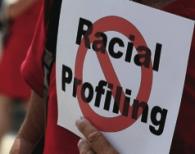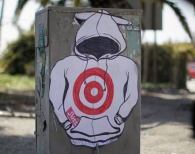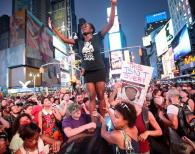“Young black men know that in far too many settings they will be seen not as individuals, but as the ‘other,’ and given no benefit of the doubt. . . . Society’s message to black boys — ‘We fear you and view you as dangerous” — is constantly reinforced. . . . Even those who keep their distance from this deadly idea are at risk of losing their lives to it. The death of Trayvon Martin vividly underscores that danger.”
—Brent Staples, New York Times
Street art in reaction to the killing of Trayvon Martin. Source: New York Times
george zimmerman
By Ryan Hunt
When the verdict for the Johannes Mehserle trial was read on July 8, 2010, I was in a Critical Thinking class at Laney Community College in Oakland, CA, the city where BART officer Mehserle shot an unarmed black resident, Oscar Grant. The announcement came through the school’s emergency response system and my class was cut short. The college advised students to make plans to get out of downtown Oakland. The involuntary manslaughter verdict was released and protesters took to the streets, which later resulted in vandalism and looting.

On June 10, George Zimmerman will stand trial on second-degree murder charges for shooting unarmed Florida teen Trayvon Martin. The 2012 shooting sparked a national conversation about racial profiling and the need to address it both in our cities and in our classrooms.
Last year, our Not In Our School program joined the NAACP, the National Educators Association, Facing History and Ourselves, Teaching Tolerance, the American Federation of Teachers, and other groups to distribute resources and materials on standing up to racial profiling.
As this case re-enters the national spotlight, let's find ways to talk about racial profiling and how can we can create environments that are safe and inclusive for all.
Click here to find Racial Profiling Curriculum & Resources

